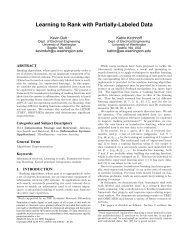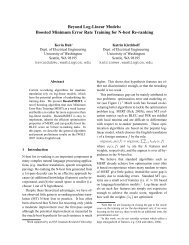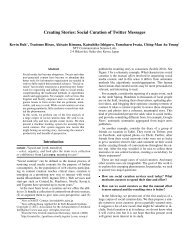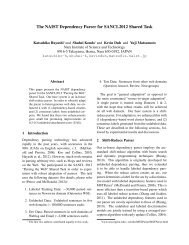file - ChaSen - 奈良先端科学技術大学院大学
file - ChaSen - 奈良先端科学技術大学院大学
file - ChaSen - 奈良先端科学技術大学院大学
- No tags were found...
You also want an ePaper? Increase the reach of your titles
YUMPU automatically turns print PDFs into web optimized ePapers that Google loves.
The Number of Question per QuerySingle QuestionMultiple QuestionsSingle Questionsentencenon-longerQuestion FocusfactoidfactoidwordphrasesentencelongerAnswer UnitwordphraseSingle Sentence QueryMultiple Sentence QueryThe Number of Sentence per QueryFigure 1.1. Division of Queries and Answer Types.Question Type Identification for multi-sentence queries. The second is extractionof descriptive answers from Web pages toward question-answering requiring descriptiveanswers. We describe these two focuses in detail below.Question Segment Extraction and Question Type IdentificationIn what way is a multi-sentence query different from a single sentence query? If amulti-sentence query is merely a set of SSQs, known question type identificationmethods would be directly applicable. A multi-sentence query can contain multiplequestions. To avoid misunderstanding, each question included in a query iscalled a question item in this thesis as appropriate. Using this term, we firstlyhave to know how a query is decomposed into question items, and what contextof a question item should be considered to classify the question item into eitherof the question types. Here, we call a set of sentences necessarily required toidentify a question item and its type question segment. We also call the processby which a multi-sentence query is separated into question segments and thenidentify their question type of segments as question type identification. In thisthesis, we clarify the structure of question segments and the conditions of ques-3










